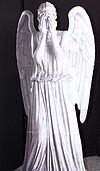Bell's theorem
| Subject classification: this is a physics resource. |
Abstract: A simple study of Bell's theorem helps students learn about vector components, polarization, wave energy, the photon, and have an introductory look at quantum measurement. Probabilities are calculated without quantum mechanics and shown violate Bell's inequality using a Venn diagram. Quantum probabilities are obtained using the classical theory of light polarization (Malus' Law), and the fact that electric field energy is proportional to the square of the electric field.



One yellow and one white ball are placed in different suitcases inside the house (no peeking!) and the suitcases are moved to different places. Qed-her opens the "local" suitcase and announces the color of the "remote" ball. This is no surprise because this genie (who hides in Italy) knows from experience that the two balls are always placed in different suitcases. But things get "spooky" when entangled objects are investigated using not two, but three hidden variables.
Calculation
editThe calculation is divided into three parts:
- Introduction describes a Bell's theorem experiment, introduces the concept of the photon, and reviews the classical theory of how light interacts with a polarizing filter. A person familiar with first year college physics may skip this section.
- Probability is calculated using classical physics by matching energy transmission to the probability that an individual photon is transmitted. For simplicity we consider the symmetric case of three polarization angles 60° apart.
- Inequality derives Bell's inequalities as simply as possible. The only result from Quantum Mechanics required is the observed fact that the two photons have orthogonal polarization, and this result may be established empirically as an experimentally verifiable fact.
- Quantum correlation calculates the symmetries for linear polarization for two different values of parity.
Consequences and insights
editHere we discuss the theorem. You are encouraged to edit or contribute to any subpage listed below.
- /Proofs reviews proofs of Bell's theorem.
- /Qed-her was introduced by User:Guy vandegrift to make the website fun, not to discredit Bell's theorem by insinuating that it is connected with the occult, fraud, or myth.
- /Weeping Angels
- Wikipedia_Lede An example of how Wikiversity tolerates parallel efforts. Students are encouraged to improve upon Wikipedia's lede. Can you be more precise? Instructions are on the talk page.
References, Links, and Footnotes
edit- J.S. Bell, On the Einstein Podolsky Rosen Paradox, Physics, 1:3 195-200, 1964. The original paper.
- Wikipedia:Bell's theorem
- Bell's Theorem Index
- Detailed list of references is under construction at /sandbox
- Bell's theorem conceptual map
See also Bell's theorem in popular culture
- Footnotes
- ↑ If you think about it, sunrises and sunsets are also paradoxical. Mermin used this language to express respect for physicists who feel that Bell's theorem is no more peculiar than the rest of quantum mechanics. The quote was borrowed from a statement musicologist Donald Francis Tovey made about a Beethoven sonata. Am. J. Physics, Vol 49, No 10, October 1981 http://web.pdx.edu/~pmoeck/pdf/Mermin%20short.pdf (Tovey: A Companion to Beethoven's Pianoforte Sontatas, Associated Board of Royal Schools of Music. London 1931 p.150
.